Click on images to enlarge
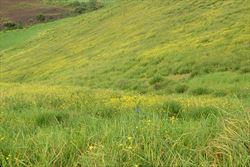
large infestation (Photo: Forest and Kim Starr, USGS)

habit (Photo: Sheldon Navie)
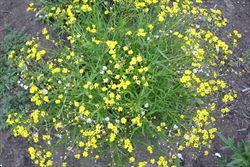
habit (Photo: Sheldon Navie)

toothed lower leaves, which are occasionally also three-lobed (Photo: Sheldon Navie)
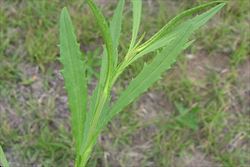
toothed upper leaves (Photo: Sheldon Navie)

close-up of stem with clasping leaf bases (Photo: Sheldon Navie)
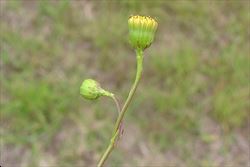
young flower-heads (Photo: Sheldon Navie)

close-up of one of the daisy-like flower-heads (Photo: Sheldon Navie)

close-up of the underside of a flower-head, showing the floral bracts (Photo: Sheldon Navie)
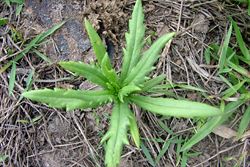
young plant (Photo: Sheldon Navie)
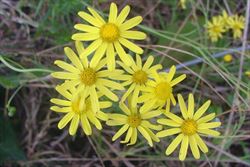
yellow flower-heads with several 'petals' (Photo: Sheldon Navie)

close-up of 'seeds' topped with fluffy hairs (Photo: Sheldon Navie)
Scientific Name
Senecio madagascariensis Poir.
Family
Asteraceae (Queensland, New South Wales, the ACT, Victoria, Tasmania, Western Australia and the Northern Territory)Compositae (South Australia)
Common Names
fire weed, fireweed, Madagascar ragwort
Origin
Native to southern Africa (i.e. South Africa and Swaziland) and Madagascar.
Naturalised Distribution
Widely naturalised in eastern Australia (i.e. in south-eastern Queensland and eastern New South Wales). Also present in inland southern New South Wales, sparingly naturalised in the ACT and near Melbourne in southern Victoria, and recently found in northern Queensland.
Also naturalised overseas in Hawaii.
Habitat
A weed of pastures, open woodlands, grasslands, suburban bushland, roadsides, disturbed sites, waste areas, parks and coastal environs in sub-tropical and and warmer temperate regions.
Habit
An upright (i.e. erect or ascending) and relatively short-lived herbaceous plant (i.e. it may be annual, biennial or perennial) usually growing 10-50 cm tall, but occasionally reaching up to 70 cm in height.
Distinguishing Features
- a short-lived or relatively long-lived herbaceous plant with much-branched stems growing 10-70 cm tall.
- its stalkless leaves are variable in shape, though they are usually quite narrow and elongated.
- the leaf margins are usually toothed, but they may sometimes be entire or lobed.
- its yellow flower-heads (15-20 mm across) have 12-15 yellow 'petals' and their bases are surrounded by about twenty greenish bracts.
- its small brown seeds are topped with a silky tuft of hairs.
Stems and Leaves
Plants can have a single main stem, or several stems that develop from a central crown at the base of the plant. These stems are much-branched towards the top of the plant and bear large numbers of flower-heads at their tips.
The alternately arranged and simple leaves (2-12 cm long and 3-25 mm wide) are variable in shape, though they are usually quite narrow and elongated (i.e. lanceolate). Leaf margins are usually toothed (i.e. denticulate to coarsely serrated), but may sometimes be entire or even lobed (i.e. pinnatifid). These leaves are all stalkless (i.e. sessile) and generally have a broad base which tends to clasp around the stem. Stems and leaves are hairless (i.e. glabrous) or sparsely hairy (i.e. puberulent).
Flowers and Fruit
The 'daisy-like' flower-heads (15-20 mm across) have 12-15 yellow 'petals' (i.e. ray florets) that are 6-14 mm long. They have a yellow centre made up of numerous tiny flowers (i.e. tubular or disc florets) and are surrounded by about twenty (19-21) greenish bracts (4-5 mm long). These flower-heads (i.e. capitula) are loosely clustered at the tips of the branches. Flowering usually occurs from late autumn through to the middle of summer, but some plants may continue to flower until late summer if conditions are favourable.
Seeds (i.e. achenes) are cylindrical in shape (1.5-3 mm long and less than 0.5 mm wide), brownish in colour and shallowly ribbed. They are covered with very tiny hairs and topped with a silky tuft (i.e. pappus) of hairs (3.5-6.5 mm long).
Reproduction and Dispersal
This plant reproduces by seed, and occasionally via crown segments.
Most dispersal of seed is by wind movement, but some seeds may be spread by animals, vehicles and in contaminated agricultural produce.
Environmental Impact
Fireweed (Senecio madagascariensis) is regarded as an environmental weed in Queensland and New South Wales. It was also recently listed as a priority environmental weed in four Natural Resource Management regions.
Legislation
This species is declared under legislation in the following states and territories:
- ACT: C1 - notifiable pest plant (a pest plant whose presence must be notified), and C4 - prohibited pest plant (a pest plant whose propagation and supply is prohibited).
- New South Wales: Class 4 - a locally controlled weed. The growth and spread of this species must be controlled according to the measures specified in a management plan published by the local control authority and the plant may not be sold, propagated or knowingly distributed (in a minority of local authority areas). See the New South Wales Department of Primary Industries Noxious Weeds List at http://www.dpi.nsw.gov.au for more detailed information on which local areas are covered in these declarations.
- Queensland: Class 2 - landowners must take all reasonable steps to keep land free of this species (throughout the entire state). It is also illegal to sell a declared plant or its seed in this state.
- Western Australia: Prohibited - on the prohibited species list and not permitted entry into the state.
Management
For information on the management of this species see the following resources:
- the Biosecurity Queensland Fact Sheet on this species, which is available online at http://www.dpi.qld.gov.au.
- the New South Wales Department of Primary Industries Agfact on this species, which is available online at http://www.dpi.nsw.gov.au.
- the Northern Territory Department of Natural Resources, Environment and The Arts Agnote on this species, which is available online at http://www.nt.gov.au/weeds.
Similar Species
Fireweed (Senecio madagascariensis) is very similar to several native and introduced species, including variable groundsel (Senecio pinnatifolius ), ragwort (Senecio jacobaea), African daisy (Senecio pterophorus) and Dalton weed (Senecio daltonii). These species can be differentiated by the following differences:
- fireweed (Senecio madagascariensis) is a low-growing and short-lived (i.e. annual or biennial) plant (20-60 cm tall). It has elongated (i.e. lanceolate), or sometimes lobed, leaves with toothed or occasionally entire margins. These leaves have mostly hairless (i.e. glabrous) upper and lower surfaces and they are stem-clasping (i.e. sessile). Its flower-heads (i.e. capitula) are usually enclosed in 19-21 bracts (i.e. involucral bracts) and they are borne in loose clusters (containing 2-10 heads). Its seeds are partially covered in short hairs that are arranged in lengthwise (i.e. longitudinal) lines.
- variable groundsel (Senecio pinnatifolius) is a low-growing and long-lived (i.e. perennial) plant (10-75 cm tall). It has elongated (i.e. linear or lanceolate), or lobed leaves, with toothed or occasionally entire margins. These leaves have mostly hairless (i.e. glabrous) upper and lower surfaces and the leaves are stem-clasping (i.e. sessile) or appear to have a stalk at the base (i.e. the base is petiole-like). Its flower-heads (i.e. capitula) are usually enclosed in 15-18 bracts (i.e. involucral bracts) and they are borne in loose clusters (containing up to 25 heads). Its seeds are usually densely hairy.
- ragwort (Senecio jacobaea) is a relatively tall and long-lived (i.e. biennial or perennial) plant (30-150 cm tall). It has deeply divided leaves (i.e. lyrate-pinnatifid or bi-pinnatisect) with irregularly toothed margins. These leaves have hairless (i.e. glabrous) upper surfaces and hairy or cobwebby lower surfaces, and they appear to have a stalk at the base (i.e. the base is petiole-like). Its flower-heads (i.e. capitula) are usually enclosed in about 13 bracts (i.e. involucral bracts) and they are usually borne in large, relatively dense, clusters.
- African daisy (Senecio pterophorus) is a tall and long-lived (i.e. perennial) plant (80-150 cm tall). It has elongated (i.e. lanceolate) leaves with toothed or occasionally entire margins. These leaves have mostly hairless (i.e. glabrous) upper surfaces and whitish or cobwebby lower surfaces. They have a narrow stalk-like base (i.e. the base is petiole-like) and the stems are winged. Its flower-heads (i.e. capitula) are usually enclosed in 18-22 bracts (i.e. involucral bracts) and they are borne in large spreading clusters.
- Dalton weed (Senecio daltonii) is a low-growing and long-lived (i.e. perennial) plant (10-50 cm tall) spreading via short underground stems (i.e. rhizomes). It has elongated (i.e. lanceolate) leaves with entire margins or with a few widely-spaced teeth along the margins. These leaves are hairless (i.e. glabrous) or sparsely hairy (i.e. puberulent) and narrow to stalks (i.e. petioles) at the base. Its flower-heads (i.e. capitula) are usually enclosed in 18-22 bracts (i.e. involucral bracts) and are usually borne singly at the tips of the short stems.

